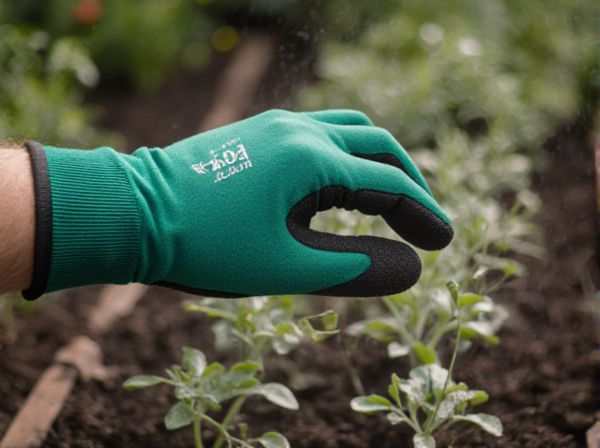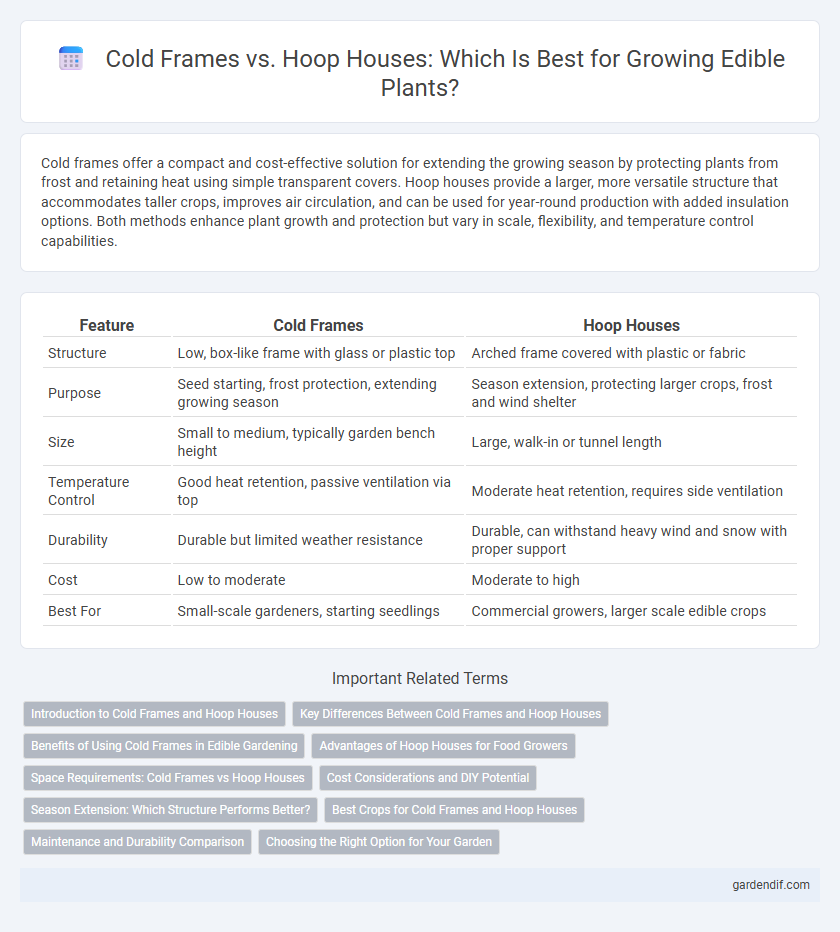
Cold frames vs Hoop houses Illustration
Cold frames offer a compact and cost-effective solution for extending the growing season by protecting plants from frost and retaining heat using simple transparent covers. Hoop houses provide a larger, more versatile structure that accommodates taller crops, improves air circulation, and can be used for year-round production with added insulation options. Both methods enhance plant growth and protection but vary in scale, flexibility, and temperature control capabilities.
Table of Comparison
| Feature | Cold Frames | Hoop Houses |
|---|---|---|
| Structure | Low, box-like frame with glass or plastic top | Arched frame covered with plastic or fabric |
| Purpose | Seed starting, frost protection, extending growing season | Season extension, protecting larger crops, frost and wind shelter |
| Size | Small to medium, typically garden bench height | Large, walk-in or tunnel length |
| Temperature Control | Good heat retention, passive ventilation via top | Moderate heat retention, requires side ventilation |
| Durability | Durable but limited weather resistance | Durable, can withstand heavy wind and snow with proper support |
| Cost | Low to moderate | Moderate to high |
| Best For | Small-scale gardeners, starting seedlings | Commercial growers, larger scale edible crops |
Introduction to Cold Frames and Hoop Houses
Cold frames and hoop houses are essential tools for extending the growing season in edible gardening by providing controlled environments that protect plants from harsh weather. Cold frames are low, transparent-roofed structures that trap solar heat, ideal for seedlings and small plants, while hoop houses feature curved frames covered with plastic to create larger, flexible growing spaces suitable for a variety of crops. Both methods improve plant survival and productivity by regulating temperature and humidity, making them invaluable for gardeners seeking to maximize yield year-round.
Key Differences Between Cold Frames and Hoop Houses
Cold frames are low, box-like structures with transparent lids used to protect plants from frost and extend the growing season by trapping solar heat. Hoop houses are larger, tunnel-shaped frames covered with plastic or fabric, providing more space and better temperature control for year-round growing. Key differences include size, with hoop houses accommodating taller plants and larger crops, and insulation efficiency, as cold frames retain heat more effectively during cold nights.
Benefits of Using Cold Frames in Edible Gardening
Cold frames in edible gardening extend the growing season by providing a controlled microclimate that protects plants from frost and harsh weather. They improve seedling survival rates and promote faster, healthier growth through enhanced temperature regulation and moisture retention. Using cold frames boosts productivity for leafy greens, herbs, and early-season vegetables, making them an efficient tool for home gardeners and small-scale organic growers.
Advantages of Hoop Houses for Food Growers
Hoop houses provide food growers with extended growing seasons by protecting crops from frost and harsh weather, enabling earlier planting and later harvesting. Their flexible design allows for easy construction and modification, making them cost-effective for small to medium-scale production. Enhanced ventilation and pest control capabilities in hoop houses improve crop quality and yield compared to cold frames.
Space Requirements: Cold Frames vs Hoop Houses
Cold frames require minimal space, typically ranging from 2 to 8 square feet, making them ideal for small gardens or urban settings. Hoop houses need significantly more area, often spanning 100 to 400 square feet or larger, suitable for larger-scale vegetable production. Choosing between the two depends on available garden space and crop volume needs.
Cost Considerations and DIY Potential
Cold frames typically cost less upfront, often ranging from $50 to $200 for basic kits or DIY builds using reclaimed materials like old windows. Hoop houses involve higher expenses, usually between $300 and $1,000, due to the larger frame, plastic coverings, and anchoring systems required, but they offer more growing space and season extension. DIY enthusiasts can more easily construct cold frames with limited tools, while hoop houses demand greater skills, materials, and time investment for effective assembly and durability.
Season Extension: Which Structure Performs Better?
Cold frames excel in season extension by providing controlled, insulated environments ideal for early spring and late fall planting, maintaining soil warmth and protecting seedlings from frost. Hoop houses offer more extensive season extension capabilities, accommodating larger crops with higher tunnels and improved ventilation, enabling growth well into late fall and early winter. For maximum season extension, hoop houses outperform cold frames due to their larger size and adaptable climate control.
Best Crops for Cold Frames and Hoop Houses
Cold frames excel at nurturing leafy greens like spinach, lettuce, and kale, which thrive in their controlled, cooler environment. Hoop houses provide an ideal setting for heat-loving crops such as tomatoes, peppers, and cucumbers, extending the growing season with enhanced warmth and protection. Both structures support early season planting, but crop selection should align with the specific microclimate each creates for optimal yield.
Maintenance and Durability Comparison
Cold frames require minimal maintenance with occasional cleaning and occasional replacement of glazing materials, offering durable protection against frost for up to 10 years. Hoop houses demand more frequent upkeep including regular inspection of plastic covers and frame tension adjustments but provide flexible, cost-effective shelter for one to three growing seasons. Both structures benefit from weather-resistant materials, yet cold frames tend to have longer lifespans due to their solid construction.
Choosing the Right Option for Your Garden
Cold frames provide a controlled environment ideal for seed starting and extending the growing season by protecting plants from frost, while hoop houses offer larger space for season extension and crop protection in diverse weather conditions. Choosing the right option depends on garden size, budget, and specific crop needs; cold frames suit small-scale gardeners seeking energy-efficient solutions, whereas hoop houses benefit larger gardens requiring more flexibility. Both structures enhance plant growth, but hoop houses allow for easier ventilation and crop rotation, making them preferable for year-round production.
Cold frames vs Hoop houses Infographic

 gardendif.com
gardendif.com